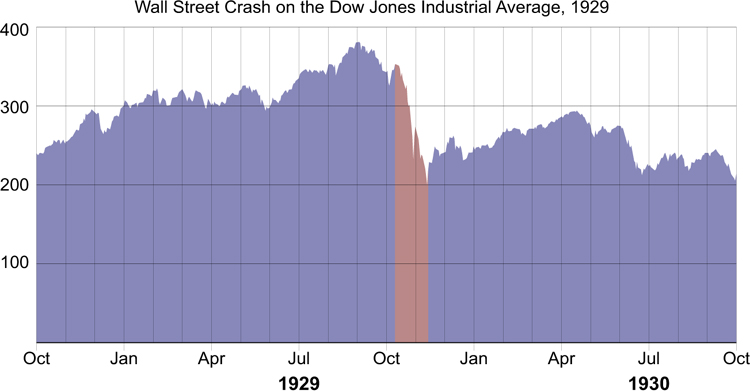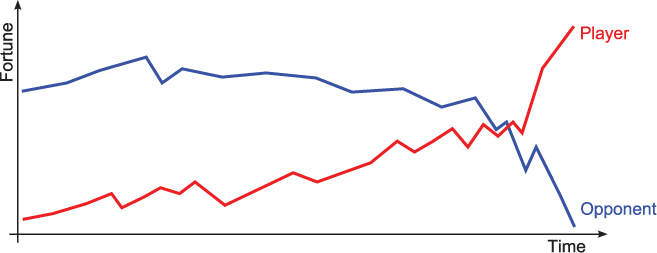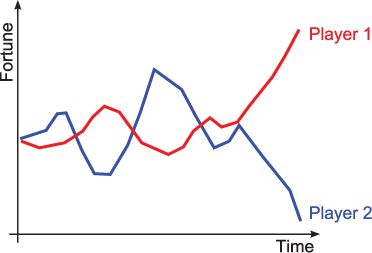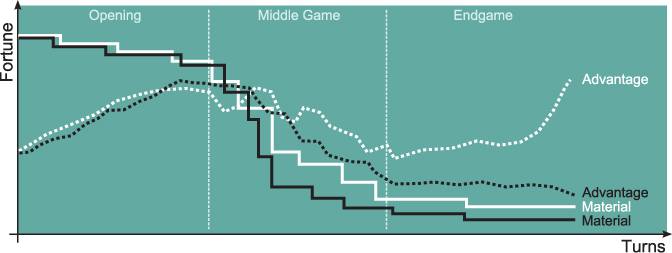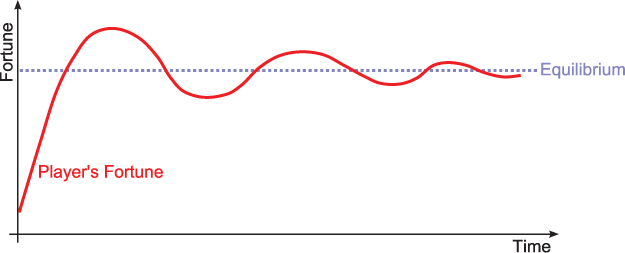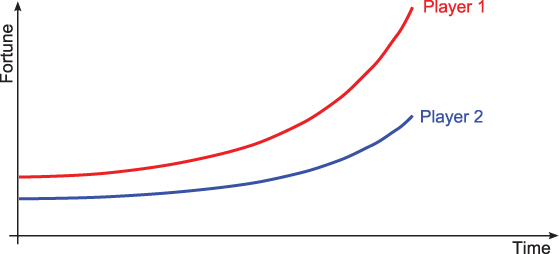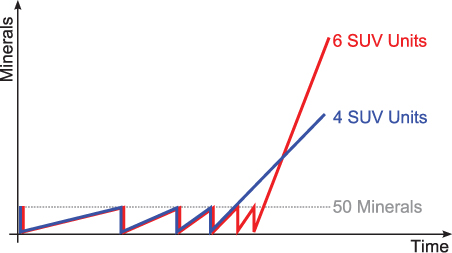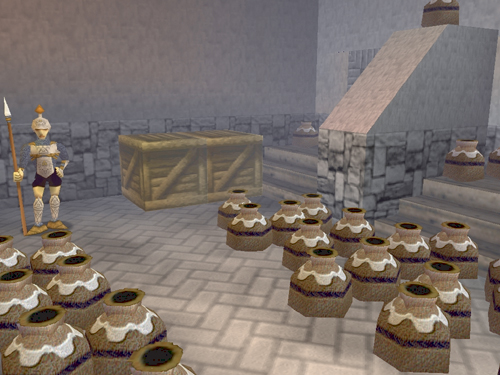Chapter 4. Internal Economy
In Chapter 1, we listed five types of mechanics that you might find in a game: physics, internal economy, progression mechanisms, tactical maneuvering, and social interaction. In this chapter, we’ll focus on the internal economy.
In real life, an economy is a system in which resources are produced, consumed, and exchanged in quantifiable amounts. Many games also include an economy, consisting of the resources the game manipulates and the rules about how they are produced and consumed. However, in games, the internal economy can include all sorts of resources that are not part of a real-life economy. In games, things like health, experience, and skill can be part of the economy just as easily as money, goods, and services. You might not have money in Doom, but you do have weapons, ammunition, health, and armor points. In the board game Risk, your armies are a vital resource that you must use and risk in a gambit to conquer countries. In Mario Galaxy, you collect stars and power-ups to gain extra lives and to get ahead in the game. Almost all genres of games have an internal economy (see Table 1.1 in Chapter 1 for some more examples), even if it does not resemble a real-world economy.
We use a very broad definition of the word economy. It’s not just about money! In an information economy, there are data producers, data processors, and data consumers. Political economy studies the way that political forces influence government policies. Economies about money are called market economies. But we use the term in a more abstract way to refer to any kind of system in which resources—of any type—can be produced, exchanged, and consumed.
To understand a game’s gameplay, it is essential to understand its economy. The economies of some games are small and simple, but no matter how big or small the economy is, creating it is an important design task. It is also one of the few tasks that belongs exclusively to the designer and no one else. To get game physics right, you need to work closely with the programmers; to get a level right, you need to work closely with the story writers and level designers; but you must design the economy on your own. This is the core of the game designer’s trade: You craft mechanics to create a game system that is fun and challenging to interact with.
In Fundamentals of Game Design, Ernest Adams discussed the internal economy of games. The discussion in this book repeats some of those points and expands the notion of internal economy.
Elements of Internal Economies
In this section, we briefly introduce the basic elements of game economies: resources, entities, and the four mechanics that allow the resources to be produced, exchanged, and consumed. This is only a summary; if you need a more in-depth introduction, please see Chapter 10, “Core Mechanics,” in Fundamentals of Game Design.
Resources
All economies revolve around the flow of resources. Resources refer to any concept that can be measured numerically. Almost anything in a game can function as a resource: money, energy, time, or units under the player’s control all are examples of resources, as are items, power-ups, and enemies that oppose the player. Anything the player can produce, gather, collect, or destroy is probably a resource of some sort, but not all resources are under the player’s control. Time is a resource that normally disappears by itself, and the player usually cannot change that. Speed is also a resource, although it is generally used as part of a physics engine rather than part of an internal economy. However, not everything in a game is a resource: platforms, walls, and any other type of inactive or fixed-level features are not resources.
Resources can be tangible or intangible. Tangible resources have physical properties in the game world. They exist in a particular location and often have to be moved somewhere else. Examples include items the avatar carries around in an inventory or trees that can be harvested in Warcraft. In a strategy game, the player’s units are also tangible resources that must be directed through the world.
Intangible resources have no physical properties in the game world—they do not occupy space or exist in a particular location. For example, once the trees in Warcraft have been harvested, they are changed into lumber, which is intangible. Lumber is just a number—it doesn’t exist in a location. The player doesn’t need to physically direct lumber to a site to build a new building. Simply having the right amount of lumber is enough to start building, even if the building is constructed far away from the location where the lumber was harvested. Warcraft’s handling of trees and lumber is a good example of how games can switch between tangible and intangible treatments of resources. Medical kits (tangible) and health points (intangible) in shooter games are another example.
Sometimes it is useful to identify resources as either abstract or concrete. Abstract resources do not really exist in the game but are computed from the current state of the game. For example, in chess you might sacrifice a piece to gain a strategic advantage over your opponent. In this case, “strategic advantage” can be treated as an abstract resource. (Abstract resources are intangible too—obviously, “strategic advantage” is not a thing stored in a location.) Similarly, the altitude of your avatar or units can be advantageous in a platform or strategy game; in this case, it might make sense to treat altitude as a resource, if only as a way of factoring it into the equation for the strategic value of capturing particular positions. The game normally does not explicitly tell the player about abstract resources; they are used only for internal computation.
Note that in video games some resources that might appear to be abstract are in fact quite concrete. For example, experience points are not an abstract resource in a role-playing game. Instead, they are an intangible, but real, commodity that must be earned and (sometimes) spent like money. Happiness and reputation are two more resources used by many games that, although they are intangible, are nevertheless concrete parts of the game.
To design a game’s internal economy or to study the internal economy of an existing game, it is most useful to start identifying the main resources and only then describe the mechanisms that govern the relationships between them and how they are produced or consumed.
Entities
Specific quantities of a resource are stored in entities. (If you are a programmer, an entity is essentially a variable.) A resource is a general concept, but an entity stores a specific amount of a resource. An entity named “Timer,” for example, stores the resource time—probably the number of seconds remaining before the end of the game. In Monopoly, each player has an entity that stores available cash resources. As the player buys and sells, pays rent and fines, and so on, the amount of cash in the entity changes. When a player pays rent to another player, cash flows from the first player’s entity to the second player’s entity.
Entities that store one value are called simple entities. Compound entities are groups of related simple entities, so a compound entity can contain more than one value. For example, a unit in a strategy game normally includes many simple entities that describe its health, damage capability, maximum speed, and so on. Collectively, these make up a compound entity, and the simple entities that make it up are known as its attributes. Thus, a unit’s health is an attribute of the unit.
Four Economic Functions
Economies commonly include four functions that affect resources and move them around. These are mechanics called sources, drains, converters, and traders. We describe them here. Again, this is a summary; for further details, see Chapter 10 of Fundamentals of Game Design.
• Sources are mechanics that create new resources out of nothing. At a certain time, or upon certain conditions, a source will generate a new resource and store it in an entity somewhere. Sources may be triggered by events in the game, or they may operate continuously, producing resources at a certain production rate. They may also be switched on and off. In simulation games, money is often generated by a source at intervals, with the amount of money created proportional to the population. As another example, some games that involve combat automatically regenerate health over time.
• Drains are the opposite of sources: They take resources out of the game, reducing the amount stored in an entity and removing them permanently. In simulation games in which it is necessary to feed a population, the food is drained at a rate proportional to the population. It does not go anywhere or turn into anything else; it simply disappears. In shooter games, ammunition is drained by firing weapons.
• Converters turn resources of one kind into another. As we mentioned, in Warcraft, trees (a tangible resource) turn into lumber (an intangible one) when the trees are harvested. The act of harvesting is a converter mechanic that converts trees into lumber at a specific rate: A given number of trees will produce a given amount of lumber. Many simulation games include technology upgrades that enable players to improve the efficiency of the converter mechanics in the game, causing them to produce more of the new resource from the old one.
• Traders are mechanics that move a resource from one entity to another, and another resource back in the opposite direction, according to an exchange rule. If a player buys a shield from a blacksmith for three gold pieces, the trader mechanic transfers the gold from the player’s cash entity to the blacksmith’s and transfers the shield from the blacksmith’s inventory to the player’s. Traders are not the same as converters. Nothing is created or destroyed; things are just exchanged.
Economic Structure
It is not particularly difficult to identify the entities and the resources that comprise an economy, but it is harder to get a good perspective on the system as a whole. If you were to make graphs of the elements in your economy, what shapes would the graphs reveal? Is the amount of a given resource increasing over time? How does the distribution of resources change? Do resources tend to accumulate in the hands of a particular player, or does the system tend to spread them out? Understanding the structure of your economy will help you find the answers.
Economic Shapes
In the real world, people represent features of an economy with charts and figures (Figure 4.1). These graphs have a few interesting properties. At the small scale, their lines move chaotically, but at larger scales, patterns become visible. It is easy to see whether a line is going up or down in the long run and to identify good and bad periods. In other words, we can recognize and identify distinctive shapes and patterns from these types of charts.
Figure 4.1. Graph of the stock market crash leading to the Great Depression. Most movement is chaotic, but the crash is clearly visible.
We can draw similar charts displaying the fortunes of players in a game. As you will see, distinctive shapes and patterns emerge from the internal economy of a game. However, there is no one shape that identifies quality gameplay. What constitutes good gameplay depends on the goals you set for your game and the context that surrounds it. For example, in one game you might want the player to struggle for a long time before managing to come out on top (Figure 4.2). In another, you might aim for quick reversals in fortune and a much shorter play-through (Figure 4.3).
Figure 4.2. A long game in which the player triumphs after an extended struggle against a powerful opponent
Figure 4.3. A short game with quick reversals of fortune
The Shape of a Game of Chess
We can take the development of players’ fortunes in a game of chess as a basis for studying shapes in game economies. In chess, the important resources are the players’ pieces. Chess players (and computer chess programs) assign a point value to each piece depending on what kind it is. For example, in one system, pawns are worth one point, rooks five, and the queen nine. Adding up the value of all the pieces one player has on the board produces a number called material. Players use their pieces to maneuver on the board to gain strategic positions. Strategic advantage can be measured as an abstract resource in the game. Figure 4.4 depicts what might be the course of play between two players in a game of chess.
Figure 4.4. The course of a particular game of chess. The color of a line indicates the color of the player it refers to.
You can discover a few important patterns in this chart. To start with, the long-term trend of both players’ main resource (material) is downward. As play progresses, players will lose and sacrifice pieces. Gaining material is very difficult. In chess, the only way to gain a piece is to bring a pawn to the other side of the board to be promoted to another, stronger piece, which would lead to an increase of material. This is a rare event that usually initiates a dramatic change of fortune for the players. If we consider only the material, chess appears to be a battle of attrition: Players who can make their material last longest will probably come out on top.
Strategic advantage is more dynamic in the game; it is gained and lost over the course of play. Players use their material to gain strategic advantage or reduce the strategic advantage of their opponents. There is an indirect relationship between the different amounts of material the players have and their ability to gain strategic advantage: If a player has more material, then gaining strategic advantage becomes easier. In turn, strategic advantage might be leveraged to take more pieces of an opponent and reduce that player’s material. Sometimes it is possible to sacrifice one of your pieces to gain strategic advantage or to lure your opponent into losing strategic advantage.
This analysis of chess is a highlevel abstraction to illustrate an economic principle using a familiar game. Classic texts on the theory of chess do not treat it in economic terms, because chess is about checkmating the king, not taking the most pieces. However, our illustration shows that gameplay and game progress can be understood in economic terms even if the game itself is not about economy.
A game of chess generally progresses through three different stages: the opening, the middle game, and the endgame. Each stage plays a particular role in the game and is analyzed differently. The opening usually consists of a sequence of prepared and well-studied moves. During the opening, players try to maneuver themselves into a position of advantage. The endgame starts when there are relatively few pieces left, and it becomes safer to involve the king in the game. The middle game falls somewhere between the opening and the endgame, but the boundaries between the stages are not clear. These three stages can also be identified from the economic analysis in Figure 4.4. During the opening, the number of pieces decreases only slowly, while both players build up strategic advantage. The middle game starts when players are exploiting their strategic advantage to take their opponents’ pieces; it is characterized by a sharper decline of material. During the endgame, the material stabilizes again as the players focus on their final attempts to push the strategic advantage to a win.
From Mechanics to Shapes
To produce a particular economic shape, you need to know what type of mechanical structures create what shapes. Fortunately, there is a direct relationship between shapes in a game’s economy and the structure of its mechanics. In the next sections, we discuss and illustrate the most important building blocks of economic shapes.
Negative Feedback Creates an Equilibrium
Negative feedback (as discussed in Chapter 3, “Complex Systems and the Structure of Emergence”) is used to create stability in dynamic systems. Negative feedback makes a system resistant to changes: The temperature of your refrigerator is kept constant even if the temperature outside the refrigerator changes. The point at which the system stabilizes is called the equilibrium. Figure 4.5 displays the effects of negative feedback.
Figure 4.5. The effect of negative feedback
The simplest shape of the equilibrium is a straight horizontal line, but some systems might have different equilibriums. An equilibrium might change steadily over time or be periodical (Figure 4.6). Changing equilibriums requires a dynamic factor that changes more or less independently of the negative feedback mechanism. The outside temperature throughout the year is an example of a periodical equilibrium that is caused by the periodic waxing and waning of the available hours of daylight and the relative strength of the sun.
Figure 4.6. Negative feedback on changing equilibriums. On the left, a rising equilibrium; on the right, a periodically changing equilibrium.
Positive Feedback Creates an Arms Race
Positive feedback creates an exponential curve (Figure 4.7). Collecting interest on your savings account is a classic example of such a curve. If the interest is the only source of money going into your savings account, the money will spiral upward, gaining speed as the accumulated sum creates more and more interest over time. In games, this type of positive feedback is often used to create an arms race between multiple players. A good example is the harvesting of raw materials in StarCraft (or similar constructions in many other RTS games). In StarCraft, you can spend 50 minerals to build a mining unit (called an SCV, for Space Construction Vehicle) that can be used to collect new minerals. If StarCraft players set aside a certain portion of their mineral income to build new SCVs, they get the same curve as money in a savings account.
Figure 4.7. Positive feedback creates exponential curves.
Obviously, StarCraft players do not spend their resources only on SCV units. They also need to spend resources to build military units, to expand their bases, and to develop new technology. However, the economic growth potential of a base in StarCraft is vital in the long run. Many players build up their defenses first and harvest many resources before pushing to destroy their enemy with a superior capacity to produce military units.
One of the most useful applications of positive feedback in games is that it can be used to make players win quickly once a critical difference is created. As should become clear from Figure 4.7, positive feedback works to amplify small differences: The difference between the balances of two bank accounts with equal interest rates but different initial deposits will only grow over time. This effect of positive feedback can be used to drive a game toward a conclusion after the critical difference has been made. After all, nobody likes to keep playing for long once it has become clear who will win the game.
Long-Term Investments vs. Short-Term Gains
If StarCraft were a race to collect as many minerals as possible without any other considerations, would the best strategy be to build a new SCV unit every time you’ve collected enough minerals? No, not exactly. If you keep spending all your income on new SCVs, you would never save any minerals, which is what you need to win the game. To collect minerals, at some point you need to stop producing SCVs and start stockpiling. The best moment to do this depends on the goals and the constraints of the game—and what the other players do. If the goal is to accumulate the biggest pile of minerals in a limited amount of time or to accumulate a specific number of minerals as quickly as possible, there is an ideal number of SCV units you should produce.
To understand this effect, look at Figure 4.8. It shows that as long as you’re investing in new SCVs, your minerals do not accumulate. However, as soon as you stop investing, the minerals increase at a steady pace. This pace depends on the number of SCV units you have. The more you have, the faster your minerals will increase. The longer you keep investing, the later you will start accumulating minerals, but you will eventually catch up and overtake anybody who started accumulating before you did. Depending on the target goal, one of those lines is the most effective.
Figure 4.8. A race of accumulation
It is a good thing StarCraft is about more than just collecting minerals. Spending all your minerals on SCV units is a poor strategy because eventually you will be attacked. You have to balance your long-term goals with short-term requirements such as the protection of your base. In addition, some players favor a tactic in which they build up an offensive force quickly in a gambit to overwhelm their opponent before they can build up their defenses—the “tank rush,” which was first made famous in Command & Conquer: Red Alert. On some maps, initial access to resources is limited, and you must move around the map quickly to consolidate your access to future resources. Investing in SCV units is a good strategy in the long run, but it requires you take some risk in the beginning, possibly giving up on quick military gains via the tank rush.
Feedback Based on Relative Scores
During Marc LeBlanc’s talk on feedback mechanisms in games at the Game Developers Conference in 1999, he described two alternate versions of basketball. In “negative feedback basketball,” for every five points that the leading team is ahead, the trailing team is allowed to field one extra player. In “positive feedback basketball,” this effect is reversed: The leading team is allowed to field one extra player for every five points they are ahead. The effects of using the difference between two players to create a feedback mechanism are slightly different from using absolute values to feed this mechanism: The effects of the feedback mechanisms affect the difference between the players, not their absolute resources. This can produce some counterintuitive effects. The economic chart of negative feedback basketball, for example, shows the lead of the better team settling on a stable distance at which the lack of the skill of the trailing team is offset by the extra players they can field (Figure 4.9).
Figure 4.9. Score graph of negative feedback basketball
When two teams are playing positive feedback basketball, the differences in skills are aggravated. When one side is better than the other, this will result in a very one-sided match. However, when both sides are closely matched, a different pattern emerges: The game will probably remain close, until one side manages to take a decisive lead after which the match becomes very one-sided again. In this latter case, a small difference in skill, an extra effort, or sheer luck can become the decisive factor.
In Chapter 6, we explore the gameplay effects of positive and negative feedback on basketball in more detail.
Uses for Internal Economies in Games
In the previous sections, we discussed the elements and common structures of internal game economies. In this section, we will discuss how game economies are typically used in games of different genres. Table 1.1 provided a quick overview of some mechanics that are typically part of that economy. Now, we will discuss the typical economic structures found across game genres in more detail.
Use an Internal Economy to Complement Physics
Obviously, physics make up the largest part of action games’ core mechanics. Physics are used to test the player’s dexterity, timing, and accuracy. Still, most action games add an internal economy to create an integral reward system or to establish a system of power-ups that requires resources. In a way, the simple use of a scoring system adds economic mechanics to many action games. If you collect points for taking out enemies, players will have to consider how much they will invest to take out that enemy. Will they put their avatars at risk, or will they waste ammunition or some sort of energy that cannot easily be regained?
Super Mario Brothers and many other similar platform games use a simple economy to create a reward system. In Super Mario Brothers, you can collect coins to gain extra lives. Because you need to collect quite a few coins, the designer can place them liberally throughout a level and add or remove them during play-testing without affecting the economy significantly. In this way, coins can be used to guide a player through a level. (Collectible objects that are used to guide players are often called breadcrumbs.) It is safe to assume that you are able to reach all coins, so if you spot a coin, there must be a way to reach it. This creates the opportunity to reward skillful players for reaching difficult places in the game. Used in this way, the internal economy of the game can be very simple. However, even a simple economy like this already involves a feedback loop. If players go out of their way to collect many coins, they will gain more lives, thus allowing them to take more risks to collect more coins.
When setting up a system like this, you must be careful to balance the risks and rewards. If you lure players into deadly traps with just a single coin, you are inviting them to risk a life to gain a single coin. That simply isn’t fair, and the player will probably feel cheated. As a designer, you have a responsibility to match the risks and rewards, especially when they are placed close to the path novice players will take. (Creating a reward that the player can see but never reach is even worse—it causes players to take risks for rewards they can never obtain.)
Power-ups, including weapons and ammunition in first-person shooters, create a similar economy. Power-ups and ammo can be rewards in themselves, challenging the player to try to eliminate all enemies in a level. As a game designer, you have to make sure that the balance is right. In some games, it is perfectly all right if killing enemies will, on average, cost more bullets than the players can loot from their remains. However, if this leads to a situation in which the player is eventually short on the proper ammo for the big confrontation with a boss character, you risk penalizing players for making an effort in the game. In survival-oriented first-person shooters, creating a scarce economy of weapons and ammo is generally a good thing because it adds to the tension and the drama, but it is a difficult balance to create. If your shooter is more action-oriented, then it is probably best to make sure there is plenty of ammo for the player, and you should make sure that taking out extra enemies is properly rewarded.
Use an Internal Economy to Influence Progression
The internal economy of a game can also be used to influence progression through a game that involves movement. For example, power-ups and unique weapons can play a special role in an action game’s economy. They can be used to gain access to new locations. A double-jump ability in a platform game will allow the player to reach higher platforms that were initially unreachable. In economic terms, you can think of these abilities as new resources to produce the abstract resource access. Access can be used to gain more rewards or can be required to progress through the game.
In both cases, as a designer, you should be wary of a deadlock situation. For example, you might have a special enemy guard the exit of a level. Somewhere in the same level there is a unique weapon that is required to kill that enemy with a single shot. The weapon is usable throughout the level. When the player finds the weapon, it is loaded with ten bullets, and there are no more until the next level—but the player doesn’t know this the first time playing. Now, a first-time player finds the weapon, fires a couple of shots to experiment with it, uses it on a couple of other enemies, and finds himself at the exit with one bullet left. The player fires and misses. You have just created a deadlock situation. The player needs access to the next level to gain bullets but needs bullets to gain access.
Use an Internal Economy to Add Strategic Gameplay
It is surprising how many of the strategic challenges in real-time strategy games are economic in nature. In a typical game of StarCraft, you probably spend more time managing the economy than fighting the battle. Including an internal economy is a good way to introduce a strategic dimension to a game that operates on a larger time span than most physical and/or tactical action.
One of the reasons that most real-time strategy games have elaborate internal economies is that these economies allow the games to reward planning and long-term investments. A game about military conflict with little forward planning and no long-term investments would be a game of tactics rather than strategy, because it would probably be more about maneuvering units on the battle field. To sustain a level of strategic interaction, a game’s internal economy needs to be more complicated than the internal economies that simply complement the physics of an action game. Economies in strategy games usually involve multiple resources and involve many feedback loops and interrelationships. Setting up an economy like that for the first time is challenging, and finding the right balance is even more difficult. As a designer, you need to understand the elements of the economy and develop a keen sense to judge its dynamic effects. Even if you have years of experience, it is easy to make mistakes: There have been many tweaks to the economy of games like StarCraft to retain the right balance after players developed new strategies, even after the game had been long published!
Even without a focus on the economics of production (such as StarCraft’s minerals and SCV units), internal economies can add strategic depth to almost any game. In most cases, this involves planning to use the available resources wisely. As already discussed, the economy of chess can be understood in terms of material (playing pieces) and strategic advantage. Chess is not about production, and gaining a piece in chess is unusual. Rather, the game is about using and sometimes sacrificing your material in order to produce as much strategic advantage as possible. In other words, chess is all about getting the most mileage out of your pieces.
You can find something similar in the game Prince of Persia: The Sands of Time. In this action-adventure game, the player progresses through many levels filled with dexterity and combat challenges. Early in the game, the player is awarded a magical dagger that allows that player to control time. If anything goes wrong, the player can use sand from the dagger to rewind time and to try again. This power can also be used during combat, for example just after the player has taken a big hit. In addition, the player can use sand as a magical power to freeze time. This helps when battling multiple enemies. The sand is not limitless, however. The player can rewind time only so often, but fortunately, defeating enemies provides the player with new sand. This means that, in additional to the usual action-oriented gameplay, the player has to manage a vital resource. The player must decide when is the best time to invest some sand. Different players will have different ideas about when they should use their sand. Some will use it more often to help out with combat, while others will prefer to save it for challenging jumping puzzles. In this way, the sand is a versatile resource: Players are able to use it to boost their performance where they need it most.
Use an Internal Economy to Create Large Probability Spaces
As internal economies grow more complex, the probability space of your game expands quickly. Games with a large probability space tend to offer more replay value, because players will have more options to explore than is generally achievable with a single play-through. Another benefit is that these games can also create a more personal experience, because the performance of players and their choices directly affect what parts of the probability space open up for exploration.
Games that use an internal economy to govern character development, technology, growth, or vehicle upgrades often use an internal currency to provide options to the player. This is a typical gameplay feature found in role-playing games, in which players spend in-game money to outfit their characters and spend experience points to develop skills and abilities. It is also found in certain racing games that allow players to tune or upgrade their vehicles between (or sometimes even during) races. As long as there are enough options and the options present really different solutions to problems encountered in the game, or are otherwise important to the player, this is a good strategy.
When using an internal economy to customize the gameplay, there are three things you need to watch out for. First, in an online role-playing game, if a particular combination of items and skills is more efficient than others, players will quickly identify and share this information, and the economy will be thrown off-balance. Either players will choose only that option, effectively reducing the probability space and creating a monotonous experience, or they will complain that they cannot keep up with players who did. In games like this, it is important to understand that customization features are best balanced by some sort of negative feedback. Role-playing games usually implement many negative feedback mechanisms for this reason: Every time characters gain a level and improved skills, they need more experience points to get to the next level. This effectively works to reduce the differences in levels and abilities and requires more investment from a player for each level earned.
Second, you have to be sure that the probability space is large enough that players do not end up exploring it entirely in one play session. For example, if in a role-playing game players have a rating between 1 and 5 for the attributes of strength, dexterity, and wisdom, and the player can choose which one to increase from time to time, it is generally a poor design decision to require them to upgrade all these attributes to the maximum in order to finish the game. Similarly, if the player has only limited choice over what order to upgrade her attributes, the consequences of those choices are reduced. A good way to include choices that have real consequences is to create choices that exclude each other. For example, players can generally choose only one class for their character in a role-playing game. Each class should have a unique set of different skills and abilities. In Deus Ex, the player is also presented with choices to improve the cyborg character that have gameplay consequences: The player might be forced to choose between installing a module that will render the character invisible for short periods and a special type of subdermal armor that will make the character much more resistant to damage.
Third, you should ideally design your levels in such a way that players can use different strategies to complete them. For example, in Deus Ex, the player can choose to develop a character in different ways. The player can focus on combat, stealth, or hacking as alternative ways of solving the many challenges in the game. This means that almost every level has multiple solutions. This is not an easy balance to strike. If you estimate that the player has managed to upgrade three options before a certain level, you have to take into account that the player upgraded the combat abilities three times, stealth three times, hacking three times, or perhaps all of them once. In Deus Ex, this problem is even more pronounced because all the sources of experience points that you require to upgrade are not renewable: You gain them for progressing and performing certain side quests. Going back to a previous area to harvest some more experience is not an option.
This example illustrates that the levels in games that permit customization must be more flexible, and more general, than in conventional action games, because you don’t know exactly what abilities the player’s avatar will have. Deus Ex Human Revolution contained a flaw: It allowed the players different ways to play the game but only one way to beat the boss characters, which defeated the point of allowing the players to customize their avatars.
Tips for Economy Construction Games
Games in which the player builds an economy, such as construction and management simulations, tend to have large and complex internal economies. SimCity is a good example. As players zone areas and build infrastructure, they use these building blocks to craft an economic structure that produces the resources they need to increase it even further. Building a game like this requires the designer to assemble a toolbox of mechanics that the player can combine in many interesting ways. This is even harder than designing a complete, functional, and balanced economy yourself. You have to be aware of all the different ways your economic building blocks combine. When successful, playing the game can be very rewarding, because the economy the players build up through play directly reflects their choices and strategies. This is why no two cities in SimCity are alike.
If you are designing an economy construction game, there are three strategies that can help you keep the complexity of your task under control:
• Don’t introduce all the player’s building blocks at once. Construction and management simulations typically allow the player to build something—a farm, factory, or city, for example—out of elementary units, building blocks, that play a role in the economy. (In SimCity, these are zoned land and specialized buildings.) It is a good idea to gently introduce players to the different elements in your game, a few at a time. This makes it easier to control the probability space, at least initially. By allowing certain building blocks and disallowing others, you can craft scenarios and create special challenges. If your game has no distinct levels or special scenarios, make sure that not all building options are available from the start. Have players accumulate resources before they can use the more advanced building blocks that unlock new options. Civilization is an excellent example of an economy construction game in which most of the building blocks are locked at the beginning of the game and must be unlocked one by one before the players can use them.
• Be aware of the meta-economic structure. In an ideal economy construction game, the number of ways of putting the economic building blocks together is endless. However, in most such games, certain approaches are better than others (and in games with a victory condition, some approaches are unwinnable). As a designer, you should be aware of typical constructions that might be called meta-economic structures. For example, in SimCity, a particular mix of industrial, residential, and commercial zones will prove to be very effective. Players will probably discover these structures quickly and follow them closely. One difficult, but effective, way of dealing with patterns that could become too dominant is to make sure that patterns that are effective early in the game cease to be effective later. For example, a particular layout of zones might be an effective way to grow your population initially but causes a lot of pollution in the long run. Slow-working, destructive positive feedback is a good mechanism to create this sort of effect.
• Use maps to produce variety and constrain the possibility space. SimCity and Civilization wouldn’t be nearly as much fun if you could build your city or empire on an ideal piece of land. Part of the challenge of these games is to deal with the limitations of the virtual environment’s initial state. As a designer, you can use the design of the map to constrain players or to present opportunities. So, although there might be a best way of building the economy (something that we might call a dominant meta-economic structure), it is simply not possible to do so in particular terrain. This forces players to improvise, and rewards players who are more flexible and versatile. In SimCity, the disaster scenarios in which players can unleash several natural disasters on their cities challenges their improvisation and flexibility in a similar vein; and of course, SimCity also generates disasters at random, setting back the player’s progress.
Summary
In this chapter, we introduced the essential elements of an internal economy: resources, entities, and some of the mechanics that manipulate them, including sources, drains, converters, and traders. We examined the concept of economic shapes as seen through graphs and showed how different mechanical structures can produce different shapes. Negative feedback creates equilibrium, while positive feedback creates an arms race among opponents. Implemented another way, positive feedback can produce a downward spiral, because a player finds it harder and harder to grow his economy. Feedback systems based on relationships between two players can produce effects that keep games close or tend to cause the player in the lead to stay in the lead.
Game designers can use internal economics in many ways to make games interesting, enriching both the progression of a game and the strategic choices a player has to make. The internal economy also affects the competitive landscape between diverse or closely matched players in multiplayer games. The chapter ended with specific suggestions about how to build games in which players construct an economy, as in SimCity.
Exercises
1. Identify the resources and economic functions in a published game. (Your instructor may specify particular games to study.)
2. Find an example of a game (not referred to in this chapter) that exhibits one of these properties: negative feedback with periodic equilibrium, a downward spiral, a short-term versus long-term investment trade-off, feedback based on players’ relative scores, or rubberbanding. Explain which resources are involved, and show how the game’s mechanics produce the effect you discovered.
3. Find an example of a game (other than a Zelda game) in which a deadlock may occur. Does the game provide a means of breaking the deadlock? Explain.

